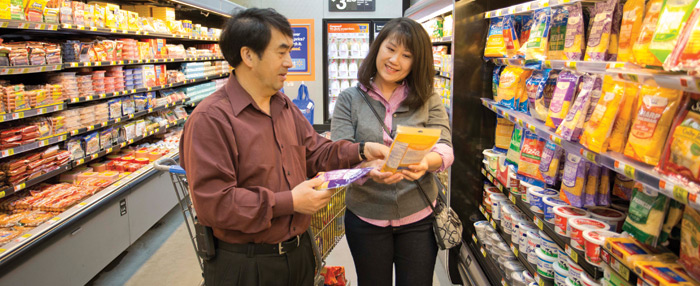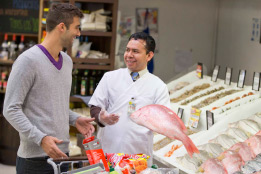Environment
Leveraging our global scale
Globally, there’s growing concern regarding food and nutrition. In fact, the United Nations estimates food production must increase by roughly 70 percent to feed the estimated 9 billion people who will inhabit the planet by 2050.
As the world’s largest grocer, we have an opportunity and the responsibility to use our global scale and resources to play a significant role in contributing to solutions for one of the most important issues facing our world today. We’re forming direct connections between farmers, markets and training. And in doing so, we’re strengthening local economies, providing long-term access to affordable food and creating supply chain transparency. The following represents a sampling of the progress we’ve made in three critical focus areas:
Produce more food with fewer resources
- Pilot commodity optimization program: We collaborated with 15 large suppliers — representing 30 percent of our food and beverage sales in North America — to pilot commodity optimization. For example, by providing farmers with data and tools, they’re able to develop plans to optimize fertilizer and tilling practices in corn and soy crop rotations. By doing so, they save money, reduce greenhouse gas (GHG) and, ultimately, deliver more sustainable products to customers. The pilot commodity optimization program includes 2.5 million acres, with the potential to reduce GHG by 2.3MMT.
- Fertilizer optimization: While the work on fertilizer optimization has been foundational, we’re exploring opportunities to scale this and other pilots into a resilient sourcing strategy across food commodities. We’re in the process of developing new relationships that could total 14 million acres, with the potential to reduce GHG by an estimated 7MMT.
Support farmers and their communities
Small and medium-sized farmers in emerging markets will be counted on to meet half the increased global demand for food and clothing through 2050, and Walmart has committed to goals to improve their livelihoods:
- Sell $1 billion of goods sourced from 1 million small and medium-sized farmers in emerging markets by the end of 2015: In 2013, we undertook a mapping process to estimate the number of small and medium-sized farmers in the supply chains of Walmart private brands. Given this work, we estimate Walmart is sourcing $4 billion from 1.2 million to 1.4 million small and medium-sized farmers. We’ve focused our programmatic sourcing efforts in our produce purchasing, where we have the most direct relationship with farmers, and funded training programs for farmers in several other categories.
- Train 1 million farmers and farm workers by the end of 2016, of which we expect half to be women: By the end of 2013, Walmart and the Walmart Foundation had contributed to training 307,332 farmers and farm workers in emerging markets, of which 132,405 were women. In addition, the Walmart Foundation funded six projects in Africa and Asia in 2013, which will reach another 370,000 farmers, an estimated 258,000 of them being women.
- Increase incomes of farmers by at least 10 percent by the end of 2015: In China, we continue to work with the University of California at Davis and the Chinese Center for Agricultural Policy to conduct an income assessment of produce production bases that supply Walmart China and other retailers.

Sustainably source key food commodities
- Palm oil: The demand for palm oil in thousands of everyday products has contributed to significant deforestation around the world. With a focus on key markets, Walmart is phasing sustainably sourced palm into our private brands. In Walmart U.S., we’ve successfully transitioned 25 percent of our private brands to sustainable palm, and we’re committed to scaling that approach across all private brands where palm oil is an ingredient. To date, 27 percent of palm oil used in our private-label products globally is sustainably sourced, driven largely by the 100 percent RSPO-certified palm secured by our Asda business in the U.K.
- Beef: Beef has become a priority focus for the company, as we aim to preserve biodiversity and decrease GHG by promoting advanced environmental management plans. By working with industry and NGOs, we’ve set out to scale environmental best practices to cattle ranches and feed yards. We’re working toward a dedicated beef supply with environmental specifications, accounting for 15 percent of the industry by 2023. In addition, we continue to make progress on our commitment to ensure that none of the beef we source from Brazil contributes to deforestation. In 2013, Walmart Brazil worked with suppliers to develop a database of ranches that supply beef and rolled out supplier qualifications and continuous improvement plans. Inspired by the Beef Monitoring and Risk Management System, this work is being expanded to support all international markets that source beef from Brazil.
-
Seafood: More than 90 percent of Walmart U.S., Sam’s Club and Asda’s fresh and frozen, farmed and wild seafood is certified by Marine Stewardship Certification (MSC) or Best Aquaculture Practices (BAP), or engaged in a Fishery Improvement Project (FIP). In 2013, Walmart took another significant step forward by initiating the globalization of its sustainable seafood. Africa, Brazil, Canada and Chile are now participating in the initiative, bringing Walmart’s sustainable seafood efforts to the global fishery landscape. In addition, we engaged with other retailers, suppliers, scientists and NGOs in a TSC-led project to develop Seafood Sustainability Program Principles. These principles allow us to understand whether a sustainable seafood program has been developed and managed in a credible way.

